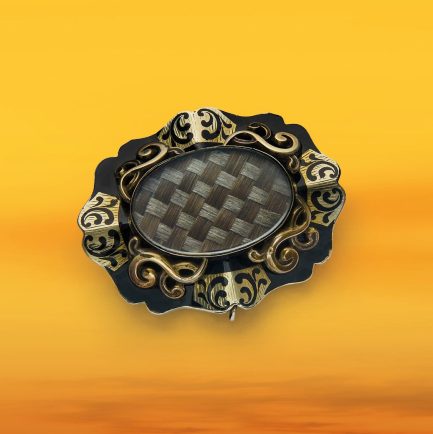A MOURNING brooch was the obscure inheritance which sparked a Warwickshire author’s writing journey.
Jean Renwick discovered the brooch among items she received following the death of her godmother Dorothy in the late 80s.
The 172-year-old brooch contained two interwoven locks of hair, which, according to the reverse inscription, belonged to Elizabeth Addy and her widow Joseph.
The history of mourning jewellery dates back to the 16th century and included rings, hair pins and pendants featuring eternal knots, silhouettes of a loved one or inscriptions.
They saw a surge in popularity following the death of Prince Albert in 1879, when Queen Victoria mourned her husband with an array of jewellery items and, perhaps more famously, the black gowns she wore until the end of her days.
The jewellery became so fashionable, it is said the country imported some 50 tonnes of human hair per year to meet demand.
It was during Victoria’s reign when the late Elizabeth who, after years of Jean’s research, it transpired was Dorothy’s great great grandmother, was commemorated by her husband with the brooch.
Jean told the Observer: “Around that time they were very fashionable and it was very much the thing to commemorate the death of someone with the brooch which incorporates their hair. You can see a lattice of grey hair and brown hair and it’s all the more touching because of that.
“It’s not the most beautiful piece of jewellery but it’s full of history and sentiment and I just find it fascinating.”
It is the engraving on the back of the brooch detailing Elizabeth’s age and the year 1849, where Jean’s story begins.
The 39-year-old left behind two daughters – aged six and six months – whose stories Jean has pieced together and retold in her book The Mourning Brooch – the first of a two part series.
It is a pivotal point at which, following their respective marriages, Jean was inspired to explore their narratives and wider family affairs further.
She said: “One married well, into a wool merchant’s family. The other daughter also married well but things go badly for them and her life turned out to be hard compared to her sister’s – their stories go in two totally different directions.”
Although it did not directly involve the daughters, one of the darker threads woven into the family history uncovered by Jean is a divorce – a rare procedure for a time when it had only just become available to the general public.
It was so rare, the press reported on the case, and the daughters would be among family members shamed by the hearing in which wife Sarah, who was pregnant at the time, successfully divorced her husband for ‘cruelty’ and adultery.
Although it is apparent there was domestic violence involved, the ‘cruelty’ was described in court as ‘that of communicating a loathsome disease’ to which, according to the national press, there was a gasp.
But it is a more romantic tale Jean explained she was most captivated by.
“One of the characters in story is being courted by an Englishman who immigrated to America at the time of the gold rush and he fell in love with this girl and he travelled seven times from California to Bradford to woo her until eventually she agrees to marry him.
“What surprises me is the appetite to travel across the Atlantic in those days which I’m going to explore in book two.”
It wasn’t until July when Jean was finally able to experience firsthand the locations where the complex tales of Dorothy’s family unfolded.
She visited the married home of one of the daughters, the church where they worshipped, and Elizabeth’s grave.
She said: “I met the vicar and he took me in and he put his hands on the pew and said: ‘Jean, your family, your people sat in these pews’ and that was a very special moment.
“It was very poignant visiting Elizabeth’s grave. Joseph had to marry again because he was left with two little girls and let’s just say there are three graves in which were buried five people, all part of the story.
“I felt very sad but also so pleased to actually pay respects to those people who once lived.”
The Mourning Brooch is available at Kenilworth Books and from Amazon.











